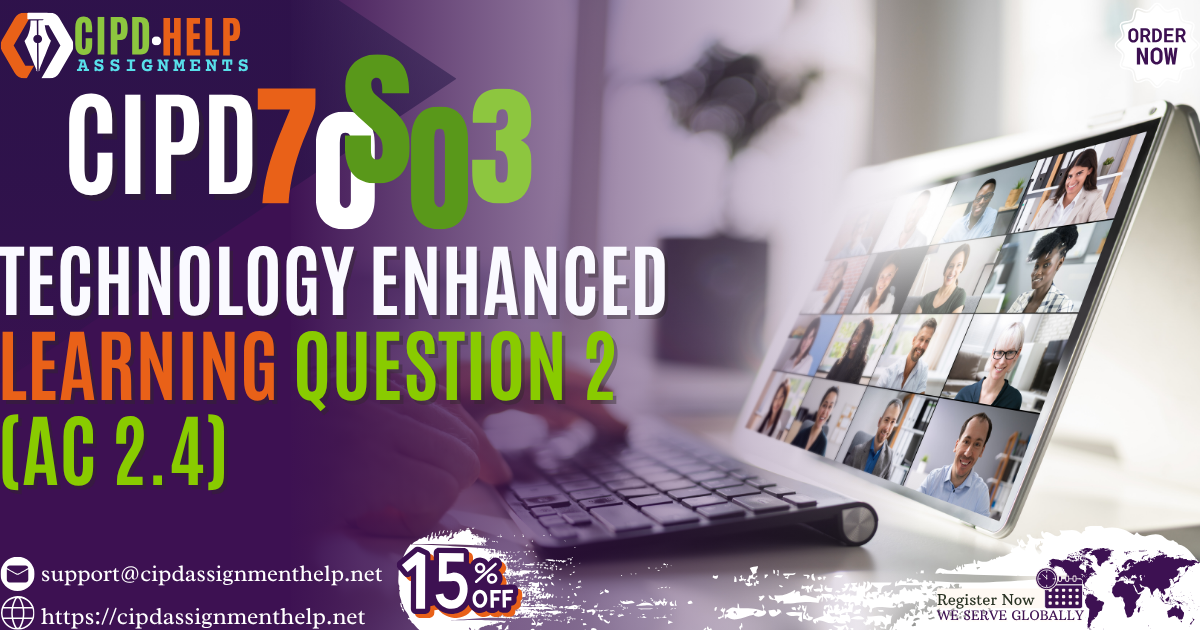7OS03 Technology Enhanced Learning Question 2 (AC 2.4)
There’s always that lingering worry, what if someone from outside gets into the system? It’s not something you think about every day, until a breach happens. 7OS03 Technology Enhanced Learning Question 2 (AC 2.4) pushes us to consider what’s really being done, or sometimes what’s missing, when it comes to shielding learning platforms and content from outside interference.
In our case, working with an organisation that’s recently moved most of its internal learning to cloud-based platforms, the question felt oddly relevant. We’ve seen teams scramble after phishing attempts or suspicious log-ins. It’s not just about systems, but about people, habits, reactions, and the kind of preventative thinking that isn’t always obvious.
This section invites a closer look, without dressing it up too much. Let’s get into it slowly, step by step.
Question 2 (AC 2.4): Drawing upon examples, critically discuss how your organisation, or one with which you are familiar, can protect existing or future learning systems and their learning content from external threats.
Alright. Let’s begin.
CIPD Unit 7OS03 – AC 2.4
Step 1: Let’s Decode the Question
The question is asking you to critically discuss. That means you’re not just describing what the organisation does. You’re thinking about:
- What is being done (or could be done),
- Why it matters, and
- What might be limiting it or putting it at risk.
Also, don’t forget this bit: “…how your organisation, or one with which you are familiar…”
You’re being asked to ground your discussion in a realistic example, preferably something you know or can relate to, not a general or abstract answer. So try to keep it tied to a genuine workplace. If you don’t have one, use a plausible one, for this, I’ll walk you through an example based on a mid-sized NHS Trust in the UK.
Finally, you’re to focus on external threats to digital learning systems and their content, think cyberattacks, data breaches, theft, misuse, unauthorised access, ransomware, fake content injection, or even social engineering tactics.
Case Example: A UK NHS Trust – Learning & Development Systems
Let’s say you’re working in a local NHS Trust, not one of the largest, but big enough to run its own e-learning platforms for mandatory staff training: safeguarding, infection control, data protection, and so on.
The Trust uses a web-based learning management system (LMS) called LearnFlex, accessible through the NHS network and externally via staff log-in.
During COVID, remote access grew massively, and so did the number of cyber threats.
Step 2: Start With Context (But Keep It Grounded)
A strong opening paragraph doesn’t need to be a long-winded intro. Just orient the reader. For example:
In recent years, digital learning platforms have become standard practice in organisations like the NHS. At the Trust I’ve worked with, staff training is delivered almost entirely online through an LMS platform, allowing flexible access to mandatory training. While the shift to online delivery has been helpful, particularly during COVID restrictions, it has also raised serious concerns around how these systems, and the content stored within them, are protected from outside threats.
Step 3: Identify the External Threats – Be Specific, Not Overgeneralised
Now, this is where you begin your discussion, what kinds of external threats are we actually talking about?
Try to avoid listing for the sake of it. Instead, walk through examples. A real organisation isn’t just worried about “cyber threats,” they’re trying to protect real content from real problems.
Let me illustrate what that might look like:
One of the more immediate threats comes from phishing attacks, which have become more sophisticated and targeted. For instance, in early 2024, NHS Digital reported an increase in credential harvesting attempts aimed at LMS platforms across the public health sector. These attacks often mimic login pages, and once a staff member enters their details, an attacker gains access to the learning content, including personal progress records and sensitive training materials.
There’s also the risk of malware being injected through third-party tools. If the LMS integrates with platforms like Zoom or document storage apps, attackers can exploit vulnerabilities in those systems as an entry point.
Step 4: Talk About What Is (or Should Be) Done to Protect Systems
Now shift to what actions the organisation is taking or could take to protect its learning systems.
Again, ground this in reality. A mid-sized NHS Trust isn’t going to have a cutting-edge AI firewall team. But they might be doing basic things well, or struggling with others.
Example:
In the Trust’s case, basic safeguards are in place, two-factor authentication (2FA) has been rolled out across most platforms, including the learning management system. Staff must use an NHS-issued token or mobile verification to log in externally. There’s also limited access to content authoring tools, only authorised learning and development officers can upload or amend materials.
That said, one area of concern remains staff awareness. Despite repeated training, some colleagues still click on suspicious links or reuse passwords across platforms. In a focus group last year, one line manager admitted they weren’t even sure how to tell if a link was safe. So while the technical protections are there, the human side of the equation feels patchy.
Step 5: Reflect on What Could Be Better – Critically, Not Harshly
Now we bring in some critique. That doesn’t mean harsh criticism. It just means noticing where things might fall short, where there are risks or weaknesses, or where improvements aren’t quite working.
Here’s a possible way to write it:
One of the issues the Trust hasn’t fully addressed is content integrity. While they back up their learning content regularly, there’s little in the way of checking for unauthorised edits. If someone managed to insert false or misleading information into a clinical training module, it might go unnoticed for some time, especially if the formatting looks legitimate. Perhaps stronger audit trails or watermarking of content could help, but as it stands, these checks are fairly manual and rely on team vigilance.
You don’t need to offer a full solution here. Just raise the point, and let the reader follow your thinking.
Step 6: Bring in Academic Support – But Lightly
You’re expected to draw on published literature. That doesn’t mean cramming in as many citations as you can. Instead, choose one or two well-placed references that support your main ideas.
Keep it human and informal, like this:
Some of this connects to wider research. For example, Clarke and Finlay (2022) found that organisational culture plays a bigger role than infrastructure in protecting learning systems suggesting that awareness and leadership behaviour matter more than just the tech stack. I think that holds true here. In my experience, the IT protocols are there, but if staff don’t take them seriously, the system still remains vulnerable.
Step 7: Tie It Back to the Question
At this point, you’ve explored the threats, considered what’s in place, and reflected on strengths and risks. You don’t need a traditional conclusion, but perhaps a final paragraph that quietly circles back to the original question.
Like this:
Overall, the Trust has made some progress in protecting its learning systems, especially on the technical side. Yet, I think the biggest threats may still lie in habits and assumptions, things that are harder to control. Digital learning is growing, but the safety of that learning depends just as much on how people interact with it as the systems themselves. That’s something I suspect still needs more attention.
Checklist in mind
So, as you write this for your assignment, keep this checklist in mind:
- Start with a brief, grounded context.
- Identify real threats, not just theoretical ones.
- Describe protective measures, both tech and human.
- Reflect on what works and what doesn’t.
- Bring in academic literature naturally, not forcefully.
- Stay critical, not just praising, but thinking.
You don’t need to impress with fancy words. You’re showing the assessor that:
- You understand the risks to digital learning.
- You can think practically and critically.
- You know how real organisations deal with these things, and that it’s not always perfect.
AC 2.4 – Protecting Digital Learning Systems and Content from External Threats
(Using the NHS Trust as an example)
Digital learning systems have become central to how organisations develop their people. In the NHS Trust I’ve been familiar with, learning and development have moved almost entirely online in recent years, driven in part by the need for flexible, remote access to training. From mandatory courses like safeguarding and infection prevention to leadership development programmes, staff engage through an LMS platform that’s accessible both within the Trust and remotely. The shift has brought a lot of benefits, but it’s also made the organisation more exposed to threats that come from outside.
One of the more visible concerns in the Trust has been around phishing attacks. These have grown more sophisticated, often mimicking official NHS communications and login pages. There was a point in early 2024 where IT flagged several fake emails targeting learners accessing the LMS from home. The risk isn’t just about stolen passwords, once someone gains access, they could potentially download sensitive learning records or tamper with course materials. It doesn’t take much for that kind of breach to shake confidence in the system.
There are also risks linked to how the LMS integrates with third-party platforms. The Trust uses video conferencing software and external document tools to deliver blended learning. Those links create new entry points for attackers. If, for instance, a content-sharing platform has a security flaw, it might not be the LMS itself that’s compromised, but the materials being fed into it. I don’t think this kind of layered vulnerability gets talked about enough, it’s easy to assume the LMS is safe just because it’s password-protected.
Now, to be fair, the Trust has taken several steps to protect the learning environment. Two-factor authentication is now required for external access. Firewalls and endpoint detection tools are in place, and IT audits are done quarterly. Only authorised learning officers can create or edit modules. There’s also encrypted cloud backup for course content, which helps restore things if a breach happens. From a purely technical point of view, the protections are there, on paper, at least.
But protection doesn’t end with systems. A recurring issue I’ve seen, and this comes up in nearly every internal staff survey, is low awareness of cyber hygiene. Despite regular data security training, it’s still common for staff to click suspicious links, or reuse the same password across multiple systems. In one session I joined, a senior nurse said she didn’t know the difference between a secure and unsecured link. It’s these everyday behaviours that often make the difference, and I think the Trust’s learning systems are only as secure as the habits of the people using them.
There’s also a blind spot in terms of content protection. While regular backups are made, there’s no automated system to detect tampering with course content. If someone were to insert false information into a clinical module, it might go unnoticed, particularly if the content was presented with the correct formatting and structure. Right now, it relies heavily on team members spotting changes manually, which isn’t foolproof. Perhaps version control logs could be reviewed more regularly, or there could be a basic alert system to flag unusual edits. It’s not about creating perfect systems, but making breaches more visible.
This challenge reflects what Clarke and Finlay (2022) suggested in their study of digital learning governance. They found that even in highly regulated sectors, organisations tend to focus on infrastructure more than culture, assuming that secure systems are enough. But in practice, culture and leadership seem to be just as important. In the Trust, there’s a formal policy on digital learning security, but I’d say its visibility is patchy. Some managers champion it; others rarely mention it. That inconsistency probably makes the overall system weaker, even if the tools themselves are secure.
I also think there’s an issue of long-term thinking. As new platforms are introduced, VR simulation, mobile apps, social learning spaces, the lines between internal and external become blurry. Are WhatsApp groups between learners considered part of the system? What about resources accessed from YouTube or third-party clinical education sites? The Trust is still working out how to protect learning in these more open, hybrid spaces. There’s a kind of grey area forming, and I’m not sure anyone’s fully figured out what the protection model should look like.
Overall, while the Trust has taken necessary technical steps to protect its learning systems from external threats, it feels like the bigger risks come from behaviour, assumptions, and blurred boundaries. There’s a tendency to assume that digital learning exists within clean, contained systems, but in practice, people learn across platforms, across devices, and often outside of tightly monitored spaces. The challenge isn’t just locking down systems, it’s keeping learning safe in an environment that’s always moving.
FAQs
1. What does 7OS03 Technology Enhanced Learning Question 2 (AC 2.4) really ask?
It’s about reviewing how your organisation, or one you know well, deals with protecting digital learning spaces from external risks. That could mean cyber threats, data leaks, or even outdated permissions.
2. Is this only about technical security systems?
Not exactly. While firewalls and backups matter, it’s also about staff behaviours, password hygiene, regular reviews, and how people respond to warning signs. It’s both human and digital.
3. Can I use a real example from a company I worked with?
Yes, and it often makes your response more grounded. A real example shows how things played out in practice, rather than just in theory. But keep it professional and anonymised if necessary.
4. What if the organisation hasn’t faced a major threat?
That’s fine. You can still discuss what’s in place to prevent issues, maybe policies that were developed, or simple things like role-based access, or limited admin rights.
5. How deep should the critique go?
Enough to show that you’re not just describing what’s there, but thinking about what works and what could be better. Question why some decisions were made. Was it cost? Convenience? Habit? All that helps build a fuller picture.





